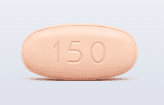Nirogacestat and Alcohol/Food Interactions
There is 1 alcohol/food/lifestyle interaction with nirogacestat.
Nirogacestat Food/Lifestyle
Major Food Interaction
GENERALLY AVOID: Grapefruit, grapefruit juice, Seville oranges, and starfruit may significantly increase the plasma concentrations and pharmacologic effects of nirogacestat. The proposed mechanism is inhibition of CYP450 3A4-mediated first-pass metabolism in the gut wall by certain compounds present in these fruits. Coadministration of multiple doses of nirogacestat (150 mg twice daily) with the moderate CYP450 3A4 inhibitors erythromycin and fluconazole are predicted to increase the AUC of nirogacestat by 2.73-fold and 3.18-fold, respectively. The interaction has not been studied with grapefruit, Seville oranges, or starfruit. In general, the effect of grapefruit juice is concentration-, dose- and preparation-dependent, and can vary widely among brands. Certain preparations of grapefruit juice (e.g., high dose, double strength) have sometimes demonstrated potent inhibition of CYP450 3A4, while other preparations (e.g., low dose, single strength) have typically demonstrated moderate inhibition. Increased systemic exposure to nirogacestat may increase the risk of adverse effects including diarrhea, ovarian toxicity, hepatotoxicity, electrolyte abnormalities, and non-melanoma skin cancers.
MANAGEMENT: Patients treated with nirogacestat should avoid consumption of grapefruit, grapefruit juice, Seville oranges, starfruit, or any supplement containing grapefruit.
References (1)
- (2023) "Product Information. Ogsiveo (nirogacestat)." SpringWorks Therapeutics, Inc.
Switch to consumer interaction data
Nirogacestat drug interactions
There are 343 drug interactions with nirogacestat.
Nirogacestat disease interactions
There is 1 disease interaction with nirogacestat which include:
More about nirogacestat
- nirogacestat consumer information
- Check interactions
- Compare alternatives
- Side effects
- Dosage information
- During pregnancy
- Drug class: miscellaneous antineoplastics
- En español
Related treatment guides
Drug Interaction Classification
| Highly clinically significant. Avoid combinations; the risk of the interaction outweighs the benefit. | |
| Moderately clinically significant. Usually avoid combinations; use it only under special circumstances. | |
| Minimally clinically significant. Minimize risk; assess risk and consider an alternative drug, take steps to circumvent the interaction risk and/or institute a monitoring plan. | |
| No interaction information available. |
See also:
Further information
Always consult your healthcare provider to ensure the information displayed on this page applies to your personal circumstances.


